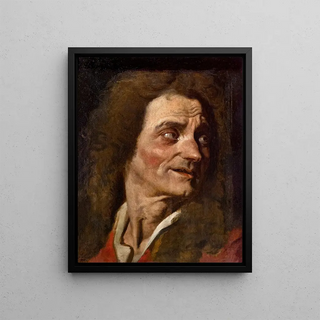Art print | Study for the Apotheosis of Homer's Head Boileau - Jean-Auguste-Dominique Ingres


View from behind

Frame (optional)
The artwork "Study for the Apotheosis of Homer's Head Boileau" by Jean Auguste Dominique Ingres represents a pivotal moment in the evolution of neoclassical art. This drawing, both delicate and powerful, embodies the artist's constant quest to capture ideal beauty and the grandeur of iconic figures in culture. Ingres, through his meticulous approach and keen eye for detail, manages to transcend mere representation to offer a true reflection on the legacy of art and literature. By examining this study, viewers are invited to explore the depths of Ingres's artistic thought, as well as his admiration for past masters, while feeling the timelessness of his work.
Style and uniqueness of the work
Ingres's work is distinguished by its refined style and pursuit of formal perfection. In this study, Homer's head Boileau is depicted with precision that demonstrates the artist's technical expertise. The lines are both fluid and rigorous, creating a harmonious balance between movement and stability. Ingres uses a subtle contrast between shadow and light to emphasize the facial features, giving his subject palpable psychological depth. This drawing, far from being a simple sketch, presents itself as a complete work, revealing the very essence of Homer's personality while evoking the grandeur of the French literary tradition. The mastery of proportions and clarity of contours testify to an relentless pursuit of beauty, characteristic of neoclassicism, while also revealing a romantic sensitivity that foreshadows future artistic movements.
The artist and his influence
Jean Auguste Dominique Ingres, an emblematic figure of neoclassicism, left his mark on the history of art in the 19th century. Trained at the Toulouse Academy and then in Paris, he was able to combine academic rigor with personal innovation. His work was deeply influenced by his studies of old masters, particularly Raphael, but also by contemporary ideas that challenged

Matte finish

View from behind

Frame (optional)
The artwork "Study for the Apotheosis of Homer's Head Boileau" by Jean Auguste Dominique Ingres represents a pivotal moment in the evolution of neoclassical art. This drawing, both delicate and powerful, embodies the artist's constant quest to capture ideal beauty and the grandeur of iconic figures in culture. Ingres, through his meticulous approach and keen eye for detail, manages to transcend mere representation to offer a true reflection on the legacy of art and literature. By examining this study, viewers are invited to explore the depths of Ingres's artistic thought, as well as his admiration for past masters, while feeling the timelessness of his work.
Style and uniqueness of the work
Ingres's work is distinguished by its refined style and pursuit of formal perfection. In this study, Homer's head Boileau is depicted with precision that demonstrates the artist's technical expertise. The lines are both fluid and rigorous, creating a harmonious balance between movement and stability. Ingres uses a subtle contrast between shadow and light to emphasize the facial features, giving his subject palpable psychological depth. This drawing, far from being a simple sketch, presents itself as a complete work, revealing the very essence of Homer's personality while evoking the grandeur of the French literary tradition. The mastery of proportions and clarity of contours testify to an relentless pursuit of beauty, characteristic of neoclassicism, while also revealing a romantic sensitivity that foreshadows future artistic movements.
The artist and his influence
Jean Auguste Dominique Ingres, an emblematic figure of neoclassicism, left his mark on the history of art in the 19th century. Trained at the Toulouse Academy and then in Paris, he was able to combine academic rigor with personal innovation. His work was deeply influenced by his studies of old masters, particularly Raphael, but also by contemporary ideas that challenged






